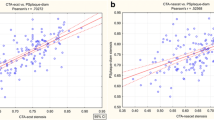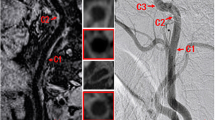Abstract
Purpose
This study was undertaken to prospectively evaluate the diagnostic performance of colour Doppler ultrasonography (CDUS), first-pass (FP) and steady-state (SS) contrast-enhanced magnetic resonance angiography (MRA) and computed tomography angiography (CTA) of the carotid arteries using digital subtraction angiography (DSA) as the reference standard.
Materials and methods
A total of 170 patients with previous cerebrovascular events and suspected carotid artery stenoses underwent CDUS, blood-pool MRA, CTA and DSA. Accuracy, sensitivity, specificity, positive predictive value (PPV) and negative predictive value (NPV) were calculated for CDUS, FP MRA, SS MRA and CTA. The McNemar and Wilcoxon tests and receiver operating characteristic (ROC) curve analysis were used to determine significant differences (p<0.05) between the diagnostic performances of the four modalities, and the degree of stenosis was compared using linear regression.
Results
A total of 336 carotid bifurcations were studied. The area under the curve (AUC) for degree of stenosis was: CDUS 0.85±0.02, FP MRA 0.982±0.005, SS MRA 0.994±0.002 and CTA 0.997±0.001. AUC analysis showed no statistically significant difference between CTA and MRA (p=0.0174) and a statistically significant difference between CDUS and the other techniques (p<0.001). Plaque morphology analysis showed no significant difference between CTA and SS MRA; a significant difference was seen between CTA and SS MRA versus FP MRA (p=0.04) and CDUS (p=0.038). Plaque ulceration analysis showed a statistically significant difference between MRA and CTA (0.04< p<0.046) versus CDUS (p=0.019).
Conclusions
CTA is the most accurate technique for evaluating carotid stenoses, with a slightly better performance than MRA (97% vs. 95% for SS MRA and 92% for FP MRA) and a greater accuracy than CDUS (97% vs. 76%). Blood-pool contrast-enhanced SS sequences offer improved evaluation of degree of stenosis and plaque morphology with accuracy substantially identical to CTA.
Riassunto
Obiettivo
L’obiettivo di questo studio è stato di valutare prospetticamente l’accuratezza dell’eco-color Doppler (ECD), dell’angiografia con risonanza magnetica (angio-RM), ottenuta con sequenze di primo passaggio (PP) ed allo stato stazionario (SS) e dell’angiografia con tomografia computerizzata (angio-TC) nella diagnostica della stenosi carotidea utilizzando l’angiografia con sottrazione digitale (DSA) come metodica di riferimento.
Materiali e metodi
Centosettanta pazienti sintomatici e con sospetta stenosi carotidea sono stati sottoposti ad ECD, angio-RM, angio-TC e DSA. Accuratezza, sensibilità, specificità, valore predittivo positivo (VPP) e valore predittivo negativo (VPN) sono stati calcolati per ECD, angio-RM ed angio-TC. Le differenze di performance tra le metodiche sono state valutate utilizzando il test di McNemar, il test di Wilcoxon e l’analisi delle curve receiver operating characteristic (ROC) (p<0,05). Inoltre il valore di stenosi attribuito dalla valutazione dell’ECD, dell’angio-RM e dell’angio-TC è stato confrontato con il valore della DSA tramite regressioni lineari.
Risultati
Sono state valutate 336 biforcazioni carotidee. Per la valutazione del grado di stenosi è stata calcolata l’area sotto la curva (AUC) delle quattro metodiche che è risultata: ECD 0,85±0,02, angio-RM PP=0,982±0,005, angio-RM SS=0,994±0,002 ed angio-TC=0,997±0,001 con sostanziale equivalenza tra angio-TC ed angio-RM (p=0,0174) ed una differenza statisticamente significativatra l’ECD e le altre metodiche (p<0,001). Per la valutazione della morfologia di placca l’analisi delle AUC delle quattro metodiche ha evidenziato una sostanziale equivalenza tra angio-TC ed angio-RM con SS, ma ha evidenziato una lieve differenza di entrambe le metodiche nei confronti dell’angio-RM con PP (p=0,04) e dell’ECD (p=0,038). La valutazione delle ulcere ha evidenziato una differenza statisticamente significativa tra l’angio-RM e l’angio-TC (p=0,04–0,046) e l’ECD (p=0,019).
Conclusioni
L’angio-TC è la metodica più affidabile con una leggera superiorità diagnostica rispetto all’angio-RM (97% vs. 95% per le sequenze SS e 92% per le sequenze PP) ed una superiorità molto marcata rispetto all’ECD (97% vs. 76%). L’angio-RM con l’utilizzo delle sequenze allo stato stazionario ottenute con mezzo di contrasto intravascolare ad alta relassività tende sostanzialmente ad eguagliare l’accuratezza dell’angio-TC.
Similar content being viewed by others
References/Bibliografia
Rothwell PM, Coull AJ, Silver LE et al (2005) Population-based study of event-rate, incidence, case fatality, and mortality for all acute vascular events in all arterial territories (Oxford Vascular Study). Lancet 366:1773–1783
Rothwell PM, Eliasziw M, Gutnikov SA (2003) Analysis of pooled data from the randomised controlled trials of endarterectomy for symptomatic carotid stenosis. Lancet 361:107–116
Rothwell PM, Mehta Z, Howard SC et al (2005) From subgroups to individuals: general principles and the example of carotid endarterectomy. Lancet 365:256–265
Fisher M, Paganini-Hill, Martin A et al (2005) Carotid plaque pathology thrombosis, ulceration and stroke pathogenesis. Stroke 36:253–257
Nandalur KR, Baskurt E, Hagspiel KD et al (2005) Calcified carotid atherosclerotic plaque is associated less with ischemic symptoms than is noncalcified claque on MDCT. AJR Am J Roentgenol 184:295–298
Kolodgie FD, Gold HK, Burke AP et al (2003) Intraplaque hemorrhage and progression of coronary atheroma. New Engl J Med 349:2316–2325
Naghavi M, Libby P, Falk E et al (2003) From vulnerable plaque to vulnerable patient: a call for new definitions and risk assessment strategies: Part 1. Circulation 108:1664–1672
Bozzao A, Floris R, Pocek M et al (2001) Non-invasive assessment of epiaortic vessels. Comparison of magnetic resonance angiography with gadolinium, spiral computerized tomography angiography, and digital angiograph. Radiol Med 101:48–53
Saba L, Sanfilippo R, Pirisi R et al (2007) Multidetector-row CT angiography in the study of atherosclerotic carotid arteries. Neuroradiology 49:623–637
Saba L, Mallarini G (2008) MDCTA of carotid plaque degree of stenosis: evaluation of interobserver agreement. AJR Am J Roentgenol 190:W41–W46
Nighoghossian N, Derex L, Douek P (2005) The vulnerable carotid artery plaque: current imaging methods and new prospectives. Stroke 36:2764–2772
Pediconi F, Fraioli F, Catalano C et al (2003) Gadobenate dimeglumine (Gd-DTPA) vs gadopentetate dimeglumine (Gd-BOPTA) for contrast-enhanced magnetic resonance angiography (MRA). Radiol Med 106:87–93
Caravan P, Cloutier NJ, Greenfield MT et al (2002) The interaction of MS-325 with human serum albumin and its effect on proton relaxation rates. JACS 124:3152–3162
Rohrer M, Bauer H, Mintorovitch J et al (2005) Comparison of magnetic properties of MRI contrast media solutions at different magnetic field strengths. Invest Radiol 40:715–724
Napoli A, Catalano C, Anzidei M et al (2007) Imaging the whole body atherosclerosis: high resolution MR angiography using blood pool agent: initial clinical experience. Minerva Cardioangiol 55:291–301
Anzalone N, Scotti R, Vezzulli P (2006) High relaxivity contrast agents in MR angiography of carotid arteries. Eur Radiol 16(Suppl 7):M27–M34
Stary HC, Chandler AB, Dinsmore RE et al (1995) A definition of advanced types of atherosclerotic lesions and a histological classification of atherosclerosis. A report from the Committee on Vascular Lesions of the Council on Arteriosclerosis, American Heart Association. Circulation 92:1355–1374
Landis JR, Koch GG (1977) The measurement of observer agreement for categorical data. Biometrics 33:159–174
North American Symptomatic Carotid Endarterectomy Trial Collaborators (1991) Beneficial effect of carotid endarterectomy in symptomatic patients with high grade carotid stenosis. New Engl J Med 325:445–453
Knox J, Whittemore AD (1996) Spiral computed tomographic angiography in evaluation of the carotid bifurcation. Adv Vasc Surg 4:97–107
Nonent M, Serfaty J, Nighoghossian N et al (2004) Concordance rate differences of 3 noninvasive imaging techniques to measure carotid stenosis in clinical routine practice. Stroke 35:682–686
Vogt FM, Goyen M, Debatin JF (2003) MR angiography of the chest. Radiol Clin N Am 41:29–41
Meany JF (2003) Magnetic resonance angiography of the peripheral arteries: current status. Eur Radiol 13:836–852
Koelemay M, Nederkoorn P, Reitsma JB, Majoie CB (2004) Systematic review of computed tomographic angiography for assessment of carotid artery disease. Stroke 35:2306–2312
Cinat M, Lane CT, Pham H et al (1998) Helical CT angiography in the preoperative evaluation of carotid artery stenosis. J Vasc Surg 28:290–300
Saba L, Caddeo G, Sanfilippo R et al (2007) Duplex scanning and CT angiography in the diagnosis of carotid artery occlusion: a prospective study. AJNR Am J Neuroradiol 28:1061–1066
Nederkoorm P, Mali W, Eikelboom B et al (2002) CT and ultrasound in the study of ulcerated carotid plaque compared with surgical results: potentialities and advantages of multidetector row CT angiography. Stroke 33:2003–2008
Fuijtani RM, Kafie F (1999) Screening and preoperative imaging of candidates for carotid endarterectomy. Semin Vasc Surg 12: 261–274
Bluemke DA, Stillman AE, Bis KG et al (2001) Carotid MR angiography: phase II study of safety and efficacy for MS-325. Radiology 219:114–122
Yuan C, Murakami JW, Hayes CE Tsuruda JS et al (1995) Phased-array magnetic resonance imaging of the carotid artery bifurcation: preliminary results in healthy volunteers and a patient with atherosclerotic disease. J Magn Reson Imaging 5:561–565
Hatsukami TS, Ross R, Polissar NL, Yuan C (2000) Visualization of fibrous cap thickness and rupture in human atherosclerotic carotid plaque in vivo with high-resolution magnetic resonance imaging. Circulation 102:959–964
Kooi ME, Cappendijk VC, Cleutjens KB et al (2003) Accumulation of ultrasmall superparamagnetic particles of iron oxide in human atherosclerotic plaques can be detected by in vivo magnetic resonance imaging. Circulation 107:2453–2458
Itskovich VV, Samber DD, Mani V et al (2004) Quantification of human atherosclerotic plaques using spatially enhanced cluster analysis of multicontrast-weighted magnetic resonance images. Magn Reson Med 52:515–523
Puppini G, Furlan F, Cirota N et al (2006) Characterisation of carotid atherosclerotic plaque: comparison between magnetic resonance imaging and histology. Radiol Med 111:921–930
Kroencke TJ, Wassen MN, Pattaynama PM, et al (2003) Gadobenate dimeglutamine enhanced magnetic resonance of abdominal aorta and renal arteries. Invest Radiol 38:504–515
Goyen M, Shamsi K, Schoenberg SO (2006) Vasovist-enhanced MR angiography. Eur Radiol 16(Suppl 2):B9–B14
Thurnher SA (2005) MRA of carotid arteries. Eur Radiol 15(Suppl 5):E11–E16
Anzalone N, Scomazzoni F, Strada L et al (2005) Carotid artery stenosis: intraindividual correlation of 3D time of fight MR angiography, contrast-enhanced MR angiography, conventional DSA, and rotation angiography detection and gating. Radiology 236:204–213
Anzidei M, Napoli A, Geiger D et al (2010) Preliminary experience with MRA in evaluating the degree of carotid stenosis and plaque morphology using high-resolution sequences after gadofosveset trisodium (Vasovist) administration: comparison with CTA and DSA. Radiol Med 115:634–647
Author information
Authors and Affiliations
Corresponding author
Rights and permissions
About this article
Cite this article
Anzidei, M., Napoli, A., Zaccagna, F. et al. Diagnostic accuracy of colour Doppler ultrasonography, CT angiography and blood-pool-enhanced MR angiography in assessing carotid stenosis: a comparative study with DSA in 170 patients. Radiol med 117, 54–71 (2012). https://doi.org/10.1007/s11547-011-0651-3
Received:
Accepted:
Published:
Issue Date:
DOI: https://doi.org/10.1007/s11547-011-0651-3




